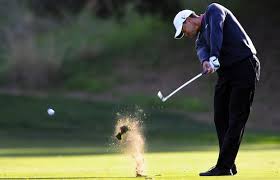This is Part 2 of the Swing Tips to let your eyes control your game. Your eyes help your feel the distance and direction of every hit. In putting, when your eyes focus on the ball during your swing, they force your head and shoulders to hit through the ball and to avoid lifting up during your putt.
Putting is a head game. If you don’t think you can sink a putt then you are destined to miss it – – – even the short ones. Confidence is a critical factor in making putts. No guts, no glory. So you better start by committing to sinking every putt. Decide that you are going to accelerate your putter through the ball and up the target line that you choose. Now you are ready to let your eyes FEEL the distance and your shoulders swing like a pendulum as your putter hits dead center on the face.
Have I got your attention? All of the following points about using your EYES to sink putts are wasted if you don’t start with a Positive Mental Attitude and the right mechanics. Your shoulders do all the work. Your elbows, wrists and fingers are locked on your putter. If you can’t lock them, practice with your GOLFSTR+ to make sure that your leading wrist is locked. Now use your eyes to make your putt on autopilot.
- On your approach shot to the green look for 2 levels on the green. You want to reach the perfect level with a high shot (and very little roll on the green) or a chip shot to roll your shot up to the hole.
- When your ball lands on the green watch the direction of the roll but be careful to discount any slice or hook caused by a poor swing of your club.
-

See the breaks and determine a target where you need to aim to handle the break.
During every putt, watch the break as your ball slows down to use this knowledge for your next putt.
- When putting, your last visual check should be up your target line for distance and direction. As your eye traces back to your ball, stop moving your head and keep your eyes focused on the back of your ball. Let you putter continue to trace back on the same line and then through the center of your ball as you swing up your target line.
- Putting is only successful if you can read the green. You can only choose your line and your speed. After that you only have 1 task. Impact on the center of your putter and hit the STRAIGHT LINE that you chose in your setup.
- Dave Stockton’s putting tip is to putt with your leading hand. The back of that hand has to continue to point at the target line even after impact as you are putting with a locked flat wrist.
- Use your eyes to see the distance you want to putt. Take a practice swing to FEEL the amount of swing you need to hit your ball that distance. Look at your target distance again and run your eyes back along the target line to STOP at your ball as your putter swings back on the same line and then through the ball on the same line as you change your focus from distance to point of impact which is dead center on your putter face.
GOLFSTR+ is a great training aid to help you learn to putt with a locked wrist. When you practice with GOLFSTR + it give you the confidence that you need to take with you during your round of golf. Buy one today at www.golfstr.com






